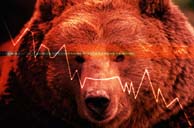Despite the stock market’s plunge over the past year, many analysts have argued that prices remain high by historical standards, raising the prospect of further declines. But Wharton finance professor
“I don’t think the historical benchmarks are relevant in today’s market,” he said April 10, speaking as the Dow Jones Industrial Average jumped nearly 258 points to close above 10,000 for the first time since March 15.
The price-to-earnings, or P/E, ratio is calculated by dividing a stock’s current price by the company’s average earnings per share over the previous 12 months. Investors buy stocks to share in a company’s current and future earnings, and a higher P/E ratio means investors are focusing less on current earnings than on those they expect in the future. Hence, the higher the ratio, the more speculative the investment — the riskier it is.
Over the 20th Century, P/E ratios for the average stock in the Standard and Poor’s 500 index averaged about 15 – a company with $1 in profits for the year had stock trading at $15. When stocks trade at less than 15 times earnings, investors are inclined to think of them as bargains. When the ratio is higher than 15, stocks are considered expensive and risky.
Many market watchers, including Siegel, believe that despite short-term price fluctuations, stocks will trade at average P/E ratios over the long term. So when the ratio is higher than average, it will be brought back to average by rising earnings, falling stock prices, or a combination of the two.
The remarkable rise in stock prices in the late 1990s far outpaced the rise in earnings. That drove the S&P 500’s P/E ratio to a stunning high of 36 in April 1999. To get back to a norm of 15, those stocks’ earnings would have to more than double, or the prices would have to fall by more than half, or the two factors would have to meet in between.
That is why many watchers were not surprised when stocks plunged in 2000 and 2001. Yet the S&P 500 is still at a historically high P/E of 24. Prices would have to drop another 37% to get the P/E back to 15, unless earnings were to soar.
Does that mean that stocks will continue to fall? Not necessarily. Siegel argues that the widely used norm of 15 is outdated. As a century-long average, it includes the Great Depression, several prolonged recessions, periods of world war, double-digit inflation and high interest rates. “You have to take out some of these real bad events,” Siegel says. “I don’t think they’re going to happen again, because we know how to avoid those.”
In recent years, for example, the Federal Reserve has been much more effective at holding off high inflation than it was in past decades. And the Fed has been able to keep recessions short and shallow.
Improved control of the economy also means interest rates are likely to stay relatively low, making stocks more attractive than alternatives such as bonds and bank savings.
Moreover, instead of raising dividends, many companies are choosing to return profits through stock price increases created by share buybacks and investment in new operations. Investors thus postpone taxes on profits until they sell their shares, and then they pay only at the maximum 20% capital gains rate, which was lowered from 28% a few years ago. When investors receive profits through dividends, they owe taxes the year the money is received and pay at income-tax rates, which for most investors are 28% to 39.6%. In effect, delivering earnings through share-price increases rather than dividends makes stock investments more profitable.
Stock investors also have benefited from a dramatic reduction in trading costs, Siegel says. Brokerage commissions were deregulated in the 1970s, leading to the creation of discount brokerages that charge only a few dollars for trades that once would have cost hundreds. With fewer gains eaten up by commissions, investors get the same after-cost profits with lower returns.
Investors’ risks have also been reduced by the rise of mutual funds in the 1980s and 1990s, especially low-fee index funds, Siegel says. Now a small investor can spread her risk among hundreds or thousands of stocks. That was not possible in the days investors had to buy individual stocks and pay high commissions.
Taken together, all these changes make stock investing less risky and expensive than it was over most of the 20th century. Today’s investors therefore do not need as large a “risk premium” – the extra return demanded for shouldering the risk of owning stocks instead of historically safer alternatives such as government bonds or bank savings. Put another way, the risk of owning a stock at a P/E ratio of 20, instead of 15, does not seem as high as it once did.
“These factors should permanently raise the price-earnings ratio on stocks, ” Siegel said. ” I would say a P/E of 20 now would be equivalent to a P/E of 15 over the past 50 years.”
With a P/E of 24, the S&P 500 is not far off this adjusted norm. Stocks could go down further, Siegel says, but the odds are better that they will rise, especially if there is a rebound in earnings. “From a long-term standpoint, the valuation of the market is very fair, particularly in the non-technology stocks.”



